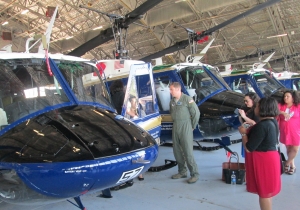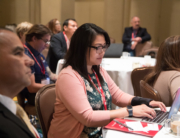by Claudia Bustamante
For USC School of Social Work students interested in working one-on-one with veterans and military families, a trip to the nation’s capital provided a meaningful lesson in understanding how policies are made and their influence on everything from the accessibility of timely mental health services to the successful reintegration of soldiers to society.
For 19 MSW@USC (online) students, a summer immersion trip to Washington, D.C. offered the opportunity to meet each other in person and a chance to appreciate the concept of government policy—a system of laws, regulatory measures, courses of action and funding priorities—that could help them as future clinicians better serve their clients.
“What kind of justice can I do with therapy if I don’t understand the whole system?” said Dina Buckey, a Kentucky-based student who always planned to pursue a clinical route after graduation. “I definitely want an LCSW (Licensed Clinical Social Worker), but now from the trip, I also need to be on top of policy changes and regulations.”
Likewise, Abigail Gellene-Beudoin from Yorktown, Va., has an interest in practicing social work.
“I’m not a macro person. Policy isn’t my interest,” she said. “But all these policies are going to affect me on the practice side in some way. It’s important to recognize that, and it was great to get that perspective.”
The students participated in the three-week immersion course Military and Veterans Policy and Practice, taught by Clinical Associate Professors Fred Stone and Eugenia Weiss at the USC School of Social Work for MSW@USC students. The course included a week in Washington, D.C., to meet with leaders from the Department of Defense, Veterans Affairs, Congress, research centers and national advocacy groups and learn how they influence and enact policies.
Practice and Policy
 Weiss was not surprised that students came to understand the value of policy.
Weiss was not surprised that students came to understand the value of policy.
“Social work is about practice and policy. As a social worker, you’re supposed to be working multi-level. That’s what sets us apart from other professions,” Weiss said.
Indeed, opportunities for social workers, especially military social workers, keep expanding. Social workers can span the micro, mezzo and macro realms. For example, they can diagnose and treat individual service members and veterans; work at organizations and nonprofits to create and implement community programs; and even become civic leaders and help draft policies.
Not all students needed convincing of the importance of policy, however.
Rosalinda Guadamuz is a Community Organization, Planning and Administration student, meaning her MSW coursework concentrates on macro-level practice.
Guadamuz, an Air Force veteran who lives in Mount Vernon, Wash., hoped the immersion course would introduce her to policymakers and help her identify what other tools might be needed for success in this field.
Originally, Guadamuz thought a law degree would help augment her studies, but the trip shifted her focus to a much more intimate scale.
“I was not considering an LCSW before this trip,” she said. “I realized I want to be in leadership. I want to help write policy. In order to get to that point, you have to have that one-one-one face time with patients to see that policies are working. I need to have that [clinical] experience.”
Beyond the Classroom
In 2009, the USC School of Social Work established a military social work program—a first of its kind among research universities—aimed at training students to work with veteran and military populations by creating a culturally competent workforce. More than 2.6 million troops have been deployed to Iraq and Afghanistan since 9/11, and many will experience transition challenges as they reintegrate into civilian society. Further, there are about 23 million veterans spanning numerous conflict eras and with varied mental and physical health challenges in the United States.
“You can study these issues. You can read articles about military sexual trauma, homeless veterans, PTSD (post-traumatic stress disorder),” said Stone. “What students got from this experience was to meet policymakers themselves. They met and spoke with people they wouldn’t normally have easy access to.”
Students met with Lt. Col. Rachel Foster, a clinical social worker with the Air Force Sexual Assault Prevention and Response Office who spoke about the military’s sexual trauma prevention efforts. They were able to speak with a key member of Rep. Charles Rangel’s office (D-New York), who last year introduced legislation in the House to upgrade service records of gay and lesbian veterans who were discharged due to sexual orientation and allow them access to veterans’ benefits. They heard how the Defense Centers of Excellence are addressing psychological health, traumatic brain injury and using telehealth throughout a service member’s career from prevention through reintegration.
“You’re learning about a lot of these things. You feel like you know it and understand, but it was great to see it applied,” said Gellene-Beudoin, a military spouse, who enjoyed a visit to the National Intrepid Center of Excellence to see how different treatment modalities are used, like service dogs.
Connecting
Aside from policy and practice elements, the trip offered a rare opportunity for MSW@USC students to network and meet in person. Students travelled to Washington, D.C., from as far away as Alaska and the Pacific Coast to eastern states like Virginia and North Carolina and many more in between.
Buckey, a military spouse and former National Guard member, said she was pleasantly surprised by how stimulating it was to meet other MSW@USC students.
“There was a really intense bonding experience with all of us that can absolutely not be experienced any other way other than face-to-face,” she said.
“If this opportunity ever comes up in the future, I cannot stress enough what an invaluable experience it is to partake in something so professionally and personally enriching.”
PHOTOS: USC School of Social Work MSW@USC students at the Martin Luther King, Jr. Memorial in Washington, D.C. (top); Students at Andrews Air Force Base (Credit: Fred Stone)








